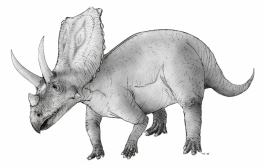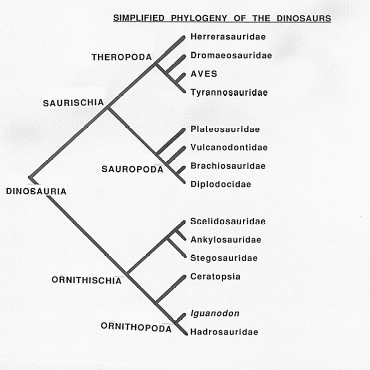Introduction
Chasmosaurus was one of the many prehistoric reptiles that roamed the plains of North America during the late Cretaceous period, about 76 to 70 million years ago. It was one of the last big dinosaurs to have evolved before the extinction of these magnificent creatures. What is interesting to note about this particular species is that it was one of the most broadly distributed species of the Mesozoic Era. Most of the dinosaurs that were found during its time, or in other words, most of the contemporaries of this huge animal were not plant-eaters. This particular creature was known to feed extensively on plants. This is strange because this creature had a very strong beak and teeth as well.
To look at, the Chasmosaurus looked like the present-day rhinoceros with wings; an animal that moves around in the same way, foraging on the plants and shrubs around it. Just like the rhinoceros, this animal could charge at an enemy presenting a very formidable and fearsome appearance as it did so (adapted from Carr, 1963; Ferguson, 1984; Halliday and Adler, 1986; Dodson, 1996).
Most of the fossils of this huge pre-historic animal point to the fact that they roamed around in what is present-day North America and Canada (Godfrey and Holmes, 1995; Holmes et al., 2001; Diem and Archibald, 2005; Sankey, 2005). The fossils have been found mainly in the states of Alberta in Canada and Texas in America. Another fact that was evident from these fossil finds is that these animals lived in herds and did not roam around solitarily. One has good reason to believe this as the fossils of the Chasmosaurus were found in large numbers, rather than as a single fossil. This herding behavior, which is common even today, was also common among the pre-historic dinosaurian herbivores.
Physical appearance
The Chasmosaurus was 16-26 feet in length and weighed around 3.5 tonnes. Most of the Chasmosaurus species that have been listed have three short horns on their face and one wide horn situated on the snout, in front of their beak. There are two more backward-facing horns (brown) just above the eyes. The skull is very large; much larger when compared to its body. The wing-like structure behind its head (which looks like a fan that has been spread and placed wide-open) gives it the appearance of a huge rhino with two horns and a broad wing. It has four short and sturdy legs. It had claws on its hoofs and the tail of this dinosaur is fairly short and quite pointed.
From the paleontological finds that have been made in a few parts of North America, it appears that the Chasmosaurus had a huge and bulky appearance. Considering the fact the Chasmosaurus had a herbivorous diet, it is understandable that it fed on most of the plants found during the Cretaceous age. The jaws looked like a beak worked better at grasping and maybe “plucking” rather than biting (Ostrom, 1966)
Taxonomic classification
The dinosaurs are classified into two distinct groups: Ornithischia and Saurischia (Appendix 3). Seeley classified the dinosaurs based on their pelvic structures. The ones that had or resembled the pelvic structures of lizards were grouped under “Saurischia” and the ones that had bird-like pelvis structures were called “Ornithischia”. Eventually, it turned out that the Ornithischians were not the predecessors of the modern birds; but the Saurischians were. The five extinct species of Chasmosaurus were
- Chasmosaurus Belli;
- Chasmosaurus Canadensis;
- Chasmosaurus brevirostris;
- Chasmosaurus russelli and
- Chasmosaurus irvinensis (recently discovered: Holmes et al. 2001).
There is a considerable taxonomic dispute regarding the classification (see Appendix 2). There is also a mention of six species of Chasmosaurus {Chasmosaurus Belli (Lambe, 1914); Chasmosaurus brevirostris (Lull, 1933); Chasmosaurus Canadensis (Lambe, 1902); Chasmosaurus kaiseki (Brown, 1933); Chasmosaurus mariscalensis (Lehman, 1989) and Chasmosaurus russelli (Sternberg, 1940).
Some of the dinosaurs that could be considered sympatric with the Chasmosaurus are Psittacosaurus, Leptoceratops, Montanoceratops, Protoceratops, Triceratops, Pachyrhinosaurus, Centrosaurus, Styracosaurus, Ankylosaurus, Corythosaurus, Dryptosaurus, and the famous Tyrannosaurus. It is possible that the Chasmosaurus could have become easy prey for the Tyrannosaurus, which has now become fairly well known.
Nature of vegetation at the time of the Chasmosaurus
During the Cretaceous age, there were a few climatic changes that covered practically all corners of the earth. There was a kind of slow spread of warming and humidity that encouraged the evolution of new plant species during this time. This was a phenomenon that was seen uniformly all over the earth. One important feature that was noticeably different now was how the plants began to reproduce. Up to now, spores (as in ferns) and naked seeds (as in conifers) ensured that a particular species lived on. The climatic changes ensured that species like tree ferns, cycads, and giant horsetails reached more or less the end of their evolutionary road and became virtually extinct.
The Cretaceous age, to which the Chasmosaurus belonged, has baffled a great many botanists and paleontologists alike. It is intriguing to note the sudden increase in the number of plant species that took place during this time. Probably this was made possible due to the proliferation of insects as well, all through the same age. With the climate becoming a lot warmer than it was till then, the number of plant species grew considerably. Along with the evolution of other insects, the bees played their part in the pollination process, thereby bringing into existence a larger number of plant species.
Among the many plants that evolved, the predecessors of plants (that are commonly found today) such as Magnolias, Figs, and Beech made their appearance during this time. By the time the Cretaceous age came to an end, a vast majority of the marine and terrestrial animals that were found hitherto became extinct. It is commonly believed that this (fairly) rapid change of vegetation and animal life was brought about by the impact of a meteorite that is said to have hit the earth during the Late Cretaceous age. This impact could have been the cause for a great deal of dust to be released; this could have in turn made irreversible changes in the food chain by containing the process of photosynthesis. Another reason that makes one believe the theory about the meteorite is the presence of huge craters that have been found. Most of these craters that are said to have been formed during the Cretaceous period are found to have an anomalous iridium layer that is indicative of a meteorite impact (Monastersky, 1993; Vines, 1999).
Conclusion
From the flora and fauna of the Cretaceous period, we can construct a fairly good idea about the paleoecology of that period. Although “The tools of paleoecology—carbon dating, stable isotopes, fossil pollen studies, and the like—could sometimes shed light on our questions” (Fox, 2006) but about the Cretaceous period not much is known; but from smaller sites like Big Bend National Park, Texas (Sankey, 2005). Paleontologists are unearthing a lot about these prehistoric animals and are only beginning to understand more about Chasmosaurus and its ilk, by putting information like a jigsaw puzzle. Till then we have to wait to know more about them.

Appendix 1
Taxonomic position of Chasmosaurus
Species: Chasmosaurus belli (syn. C. kaiseni, C. brevirostris, C. canadensis), C. irvinensis, C. russelli.
Sister genera: Agujaceratops, Anchiceratops, Arrhinoceratops, Diceratops, Eotriceratops, Pentaceratops, Torosaurus, Triceratops (syn. Triceratops ingens, Triceratops maximus, Triceratops galeus, Bison alticornis, Sterrholophus).
Appendix 2
Anatomical features of Chasmosaurus
Appendix 3

References
Brown, B. “A new longhorned belly river ceratopsian”. American Museum Novitates, 699 (1993) : 1-3.
Carr, A. “The Reptiles”. New York, Life Nature Library, (1963).
Diem, Steve and Archibald, J. David. “Range extension of southern Chasmosaurine ceratopsian dinosaurs into northwestern Colorado”, Journal of Paleontology, 79(2), 2005: 251-258.
Dodson, P. “The Horned Dinosaurs”. New Jersey: Princeton University Press, (1996).
Ferguson, M. W. (ed.) “The structure, development and evolution of Reptiles”. London: Acedemic Press, (1984).
Fox, D. (2006). “Dig deeper”. Conservation Magazine. 7(3). Web.
Godfrey, S. J. and Holmes, R. “Cranial morphology and systematics of Chasmosaurus (Dinosauria: Ceratopsidae) from the Upper Cretaceous of western Canada”, Journal of Vertebrate Paleontology, 15(4), 1995: 726-742.
Halliday, Tim and Adler, Kraig. “The encyclopaedia of Reptiles and Amphibians”. London: Allen & Unwin (1986).
Holmes, R. B., Forster, C., Ryan, H. and Shepherd, K. M. “A new species of Chasmosaurus (Dinosauria: Ceratopsia) from the Dinosaur Park Formation of southern Alberta”. Canadian Journal of Earth Science, 38 (2001) :1423-1438.
Lucas, S.G., Sullivan, R.M., and Hunt, A.P. “Re-evaluation of Pentaceratops and Chasmosaurus (Ornithischia, Ceratopsidae) in the Upper Cretaceous of the Western Interior: New Mexico”, Museum of Natural History and Science, Bulletin, 35, (2006): 367-370.
Monastersky, R. “Cretaceous die-offs: a tale of two comets? – crater of comet believed to cause mass distinction of dinosaurs found”. Science News, 1993. Web.
Ostrom, J. H. “Functional morphology and evolution of the ceratopsian dinosaurs”. Evolution, 20(3), (1966): 290–308.
Sankey, J. T. 2005. Late Cretaceous vertebrate paleoecology, Big Bend National Park, Texas; pp. 98-106. In: Dinosaur Park Symposium, Short Papers, Abstracts, and Program, D.R. Braman, F. Therrien, E.B. Koppelhus, and W. Taylor (eds.). Special Publication of the Royal Tyrrell Museum. Drumheller, Alberta, Canada.
Vines, G. “Mass extinctions”. New Scientist, No. 2216 (1999).